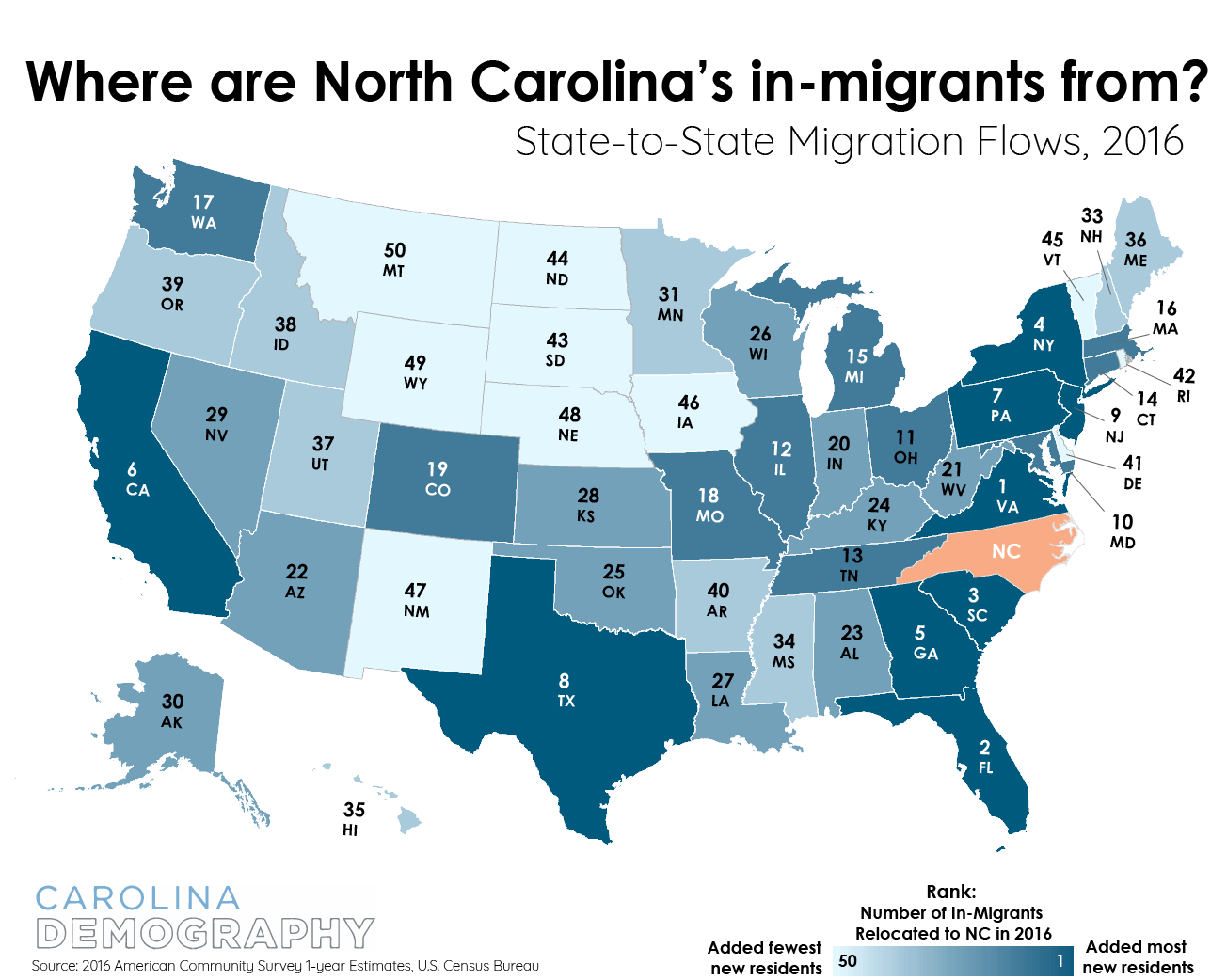Which States Contribute the Most Domestic Migrants?

Migration is the major source of North Carolina’s population growth. What states send North Carolina the most migrants?
The Census Bureau releases annual estimates on domestic and international migration flows for residents of the United States and Puerto Rico. American Community Survey respondents provide details on their place of residence one year ago and the state in which they currently live. The top 10 highest contributing states for North Carolina’s in-migrants in 2016 were Virginia, Florida, South Carolina, New York, Georgia, California, Texas, Pennsylvania, New Jersey, and Maryland.

This wide range of places raises the question: what is the main driving force behind one’s decision to relocate to a new state?
As the map below illustrates, geographic proximity unquestionably influences who moves to North Carolina: eight of the top ten states are located on the Atlantic coast. This phenomenon is consistent with one law of Ravenstein’s theory of human migration, which notes that the “majority of migrants move a short distance.” After ranking each state according to how many in-migrants it contributed in 2016, a noticeable pattern emerges. As the distance from North Carolina increases, fewer individuals from a state tend to move to North Carolina and the state’s ranking declines. Nevertheless, what might explain states like Texas or California?
Ravenstein’s theory also states that individuals who move longer distances typically relocate to areas with abundant economic opportunities. Several of North Carolina’s fastest-growing industries – banking and finance, biotech, and information technology – have played a major role in drawing outside talent to particular areas of the state. Counties within the Charlotte metro and the Research Triangle tend to have the largest percentages of non-native residents. These places may serve as a draw to individuals relocating from more distant states.
Finally, these rankings are not without inherent issues. Many of these states are smaller than North Carolina, so what may be a minor contribution to North Carolina’s population is a sizable portion of another’s. Similarly, two of our largest contributing states—California and Texas—are highly populous, meaning large numbers of migrants to North Carolina may be a relatively smaller proportion of the state’s population. North Carolina is the 11th most common destination for California movers and the 14th most common destination for Texas movers.

Need help understanding population change and its impacts on your community or business? Carolina Demography offers demographic research tailored to your needs.
Contact us today for a free initial consultation.
Contact UsCategories: Carolina Demographics

The Center for Women’s Health Research (CWHR) at the University of North Carolina School of Medicine released the 12th edition of our North Carolina Women’s Health Report Card on May 9, 2022. This document is a progress report on the…

Dr. Krista Perreira is a health economist who studies disparities in health, education, and economic well-being. In collaboration with the Urban Institute, she recently co-led a study funded by the Kate B. Reynolds Foundation to study barriers to access to…

Our material helped the NC Local News Lab Fund better understand and then prioritize their funding to better serve existing and future grant recipients in North Carolina. The North Carolina Local News Lab Fund was established in 2017 to strengthen…
Your support is critical to our mission of measuring, understanding, and predicting population change and its impact. Donate to Carolina Demography today.